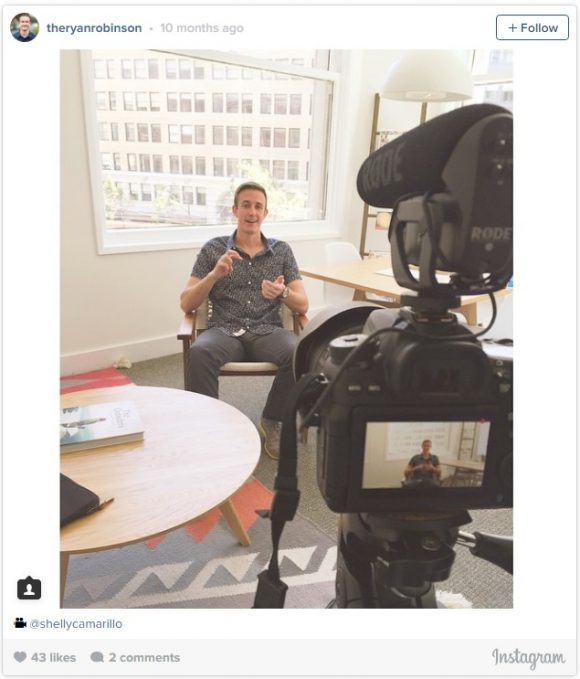
10 Steps to Becoming a Freelancer While You’re Still in College By guest author Ryan Robinson '12
May 9, 2016
Ryan Robinson ’12
is an entrepreneur and writer who helps people start profitable businesses. You can learn more about Ryan and his work by visiting his website, www.ryrob.com.
With over 54 million Americans opting to forego traditional careers, in exchange for the risks and rewards of working remotely and setting their own schedules as a freelancer, we’re seeing an unprecedented shift in the way companies function around the world.
Hiring freelancers is becoming not only more acceptable, but more attractive for many businesses. This creates an incredible opportunity for people with useful skills to start freelancing while they’re still in college, and launch into a sustainable self-employed career after graduation.
Fewer taxes, lower employee-related expenses, no health care, less office space, the list goes on. These are but a handful of the reasons many companies are seeking freelance writers, designers, marketers, and developers to help grow their businesses.

A recent study by the University of Phoenix, polling 1,600 adults under the age of 30, found that 63% of people in their 20’s either own their own business or want to in the near future. Of those who are not already entrepreneurs, 55% identified as wanting to be, one day.
So, how do those of us, regardless of age, who want to be gainfully self-employed go about getting started with our careers as entrepreneurs? Well, choosing to start freelancing is one of the most feasible, realistic, and attainable side businesses you can start while you’re still in college and don’t have as many pressures as you soon will out in the workforce.

Luckily for me, Chapman University happens to be located in sunny Orange County, California. Even though I was fortunate enough to have substantial scholarships and financial support from my parents, my cost of living was still through the roof. That, coupled with my drive to start building my personal brand, is why I chose to start a freelance business while I was still in college.
10 Steps to Becoming a Freelancer While You’re Still in College
Before getting started with freelancing, you need to get very clear on why you want to freelance in the first place. Once you have your goals in mind, how you utilize your limited amount of time around classes, internships, and keeping a social life, will greatly determine your level of success with freelancing.
1. Define Your Goals.
Without clearly defined, easily measurable goals, you’re going to have a very difficult time getting to where you want to go.
- Is freelancing a path to just earning extra income?
- Do you eventually want to become a full-time freelancer after graduating?
- Or, are you looking to use freelancing as a stepping stone to eventually achieving a different goal entirely?

Regardless of what your ultimate goal is, you need to make it abundantly clear. Take the time to understand why you’re considering freelancing, and make sure it’s the right move in your progression toward achieving your bigger picture goal.
Only after you have the clarity around where you want freelancing to take you, can you start backing into your shorter-term goals and benchmarks that’ll help you become a success.
Let’s say your bigger picture goal is to become fully self-employed as a freelancer after college. You’ll set your own hours, decide who you want to work with, and call all of the shots in your business. Now, how do you get there?
You know that you’ll need to get your freelance income up to a sustainable, healthy level that allows you to move straight into self-employment. Because I’ve quit my day job too early in the past to start a business, my personal rule is that I now must reach a side income of at least 75% of what my salaried job pays me, before even considering quitting to pursue my side business – full-time.

As a college student, this methodology can be applied by starting with your freelance income target, based on your living expenses, risk tolerance, and realistic expectations on how long your savings can sustain you after graduation. Now, you can back into a rough idea of how many clients you’ll need (and what you’ll have to charge them), before making it to the point where you’ll be able to freelance full-time.
2. Find a Profitable Niche.
Let’s assume you’re studying graphic design, or you’ve at least been building your skills with Adobe Illustrator & Photoshop as a hobby in your free time.
Clearly, there are a lot of competitors in your industry that’ll be willing to charge much lower rates than you, no matter what you do. There are people from all around the world with lower costs of living that’ll always be willing to accept lesser-paid gigs than you. Get over the idea of trying to compete on price as a freelancer, right now.
It’s not worth racing other people to the bottom, especially when sites like Fiverr and Upwork already have countless options for low-priced freelancers. Side note: I personally recommend not ever listing your services on either of those sites, unless you absolutely need to (after striking out once trying everything in this post).
By taking the time to find a profitable niche for your freelance business, you’re actively seeking out an industry and type of client that values quality. When you’re in a space that competes on quality, you’ll completely change the ways in which you sell your services.
You’ll be competing on value, not price.
Instead of taking any graphic design project that comes your way, choose to concentrate solely on infographic design for startup blogs, or eBook layouts for enterprise tech companies. Choose an area that genuinely interests you, and focus on becoming the best designer in that narrow space.
Once you’ve made yourself invaluable within your niche, you’ll have a platform by which you can expand your freelance business in any direction you’d like.
3. Identify Your Target Clients.
Just as important as finding a profitable niche, is attracting the right types of clients
As you’re just starting off as a freelancer, it’s fine to take a bit more of a shotgun approach to landing a few clients. Make some initial assumptions about who you want to work with, target them first, and after working with a few of them, you’ll develop a very clear sense of whether or not you want to continue pursuing similar clients.
Since starting my freelance business, I’ve honed my target client profile over time to match only two very specific types of businesses. High-growth tech startups and business influencers with well-established personal brands. The primary reasons I’ve narrowed down the focus of my freelance business this far, is because I work best these types of (very similar) clients, and they both run in similar circles that lead to frequent referrals. I’m building my reputation within my niche.
This is a difficult decision to make at first, because it means turning away a lot of business. However, the process of narrowing in on your target clients that you work best with, will help you achieve much better results in the long run. Once you have a few clients who are willing to advocate for you, the momentum will really pick up.

Going back to our focus of competing on value, not price, everything you do in regard to freelancing – especially when you have a very limited amount of free time – needs to point back to your ability to deliver the highest quality results for your clients. As one of my freelance idols, Paul Jarvis so eloquently put it over on the CreativeLive Blog, “make your clients so happy & successful that they become your sales force.”
By appealing so well to a narrow (well-selected) niche, your target clients will have a very quick path to deciding that you’re the best person to help them with their projects. This above all else, is the path to charging premium rates without anyone batting an eye at the first prices you throw out.
To determine the best type of target clients as you start freelancing, ask yourself these three questions:
- Which businesses will find my services useful?
- Which businesses can afford to pay the prices I’ll need to charge, in order to hit my income goal?
- Who are the decision makers within these businesses, and what can I learn about their demographics & interests? Can I find a way to connect with them on a personal level?
With my target clients, smaller startup teams and founders with personal brands, they can instantly relate to me because of my own personal affinity to startups. Because my portfolio work is directly applicable to what they do, they also start out with much more confidence that I’ll be able to drive similar results for their business, too.
4. Set Strategic Prices for Your Services.
I’ve spoken a lot about setting the right prices for your freelance business before you get started. I even architected an infographic that walks you through the process of setting your freelance hourly rate.
From a pure numbers perspective, this calculator from MotiveApp is as good as it gets for determining what your hourly rate needs to be, in order to meet your income goals and expense levels. It’s a great tool for double-checking that you’re charging enough to afford the lifestyle you want to live, but I recommend starting to determine your pricing strategy with a very different progression in mind.
Remember, you need to price yourself based on the value you deliver – not based on what your competitors are charging.
Don’t allow anyone else to dictate the terms by which you define your value. That’s not what starting a freelancing business is about.
In this post on his blog, Neil Patel chronicles many of the lessons he learned while running an SEO consulting business. One of the most prominent lessons that stuck out to me, is that the more you charge, the less clients complain. Because he very astutely selected target clients that have big budgets, he knows that they’re much more willing to spend money – in order to make that money back through investing in your services. Smaller clients, on the other hand, often don’t have as much money to play with, and thus can’t sustain much in terms of losses when projects don’t deliver big returns.
There’s no such thing as prices that are too high. Your prices may be too high (or too low) for the types of clients you’re targeting, but if you do your homework in deciding who to pitch your services to, you’ll be selling exactly what your clients need – for a price they can justify.
In my freelance business, I write well-researched, in-depth blog content for my clients. Most of my content is in the range of 1,500 – 2,500 words per piece, and designed to rank well in organic search results, which is extremely valuable for most businesses. Because my work extends beyond just writing, and into strategic distribution and driving traffic after the content publishes, I add a lot more value for my clients than any other “writer” can bring to the table. For that extra value, my prices start at $500 per post (plus distribution) and sharply go up from there, based on other requirements and add-ons.
Don’t charge too far above your value, but don’t ever undervalue what you’re doing for your clients. They’re going to hire someone to help with their projects, so it’s just a matter of showing them you’re the right person to help. Price becomes a secondary concern, if they’re already convinced that you’re the best person for the job. It’s business and they’ll make it work, or it wasn’t meant to be. Keep in mind that you won’t be the perfect person for every client.
5. Build a High-Quality Portfolio Website.

Because I’m such a huge advocate of creating a powerful online presence to support starting a freelance business, I brought in an expert, Laurence Bradford , to share all of the essential elements to building a freelance portfolio that wins you high-value clients.
As a starting point, let’s understand what the purpose of having a portfolio website is, in the first place. It’s often the first impression a potential client will have of you, your style, your work, and the past clients (or companies) you’ve worked with. You need to effectively communicate the services you offer, and who they’re for. Beyond that, you need to sell yourself on why you’re the best person for this type of work – for the clients you want to work with.
Your freelance portfolio needs to do the following, in order to be truly effective at selling your services:
- Communicate your specialty & display examples of your work.
- List your contact information & show off your personality.
- Highlight your relevant skills, education, and accomplishments.
- Display testimonials (even if they’re from coworkers or former bosses when you’re just getting started).
- Have regular updates that show your evolution, new clients, and updated sample work.
As you’re developing your portfolio site, find other freelancers within your space and get some inspiration from them, to help uncover how they’re positioning themselves, formulating their value propositions, and going about starting their businesses.
6. Create Examples of What You Can Deliver (on Your Portfolio Site).
You want your website to serve as a destination to demonstrate your expertise.
With that in mind, one of the best ways to show you’re in the know within your space, is by regularly publishing new content, images, or videos (depending upon the content medium you work in) that your target clients will be impressed with. Once you have an understanding of what your clients need, go out and create examples of that exact type of content – as if you had been hired to produce it – for your own website.
There’s no better way to sell your services, than to already show your clients that you can create what they need. What’s more, is that it’ll make their projects that much easier when you have a library of related work to pull from for inspiration.
My website is a living example of this. When I set out to freelance, I decided early on that at least once per month, I was going to make it a point to publish a very thorough 4,000+ word blog post on topics that fall under teaching my readers how to start and grow a profitable side business, the theme of everything on my site and something I have intimate experience with. One of my best examples is my epic post on the best business ideas.
It’s no coincidence that I choose to work with clients that have a very similar target market, as those who I speak to on my personal blog here. All my potential clients need to do, is check out a couple of my posts to see how much engagement they get, pick up on my conversation style, and get a feel for how I’d be able to work with them & their audience.
If you’re a web designer, your portfolio site should be very meticulously curated since everything about it, is a representation of what you’ll be able to build for your clients. If you’re a writer like me, then your blog posts need to speak to the quality of work you’ll create for everyone you work with. For designers, the same thing goes – make sure the images you feature on your site are representative of the style you want to create for your future clients.
7. Thoughtfully Choose Your First Clients.
Because you have a very limited amount of time to source new clients (and actually do the work for them) as you start freelancing, you need to get the most out of the clients you do bring on. Both from a financial and portfolio-building standpoint.

Your limited number of clients and correlating portfolio pieces, will represent how you’re perceived by other potential clients moving forward.
That makes everyone you choose to work with or highlight on your website, a crucial decision – especially in the beginning. Obviously you don’t want to overthink it and go into decision paralysis, but spend a minute or two thinking through whether or not each potential client you’re considering, will help you get to where you want to go.
Right now, I only keep 2 clients at a time. It’s not for lack of work requests that come in, but rather because I’ve chosen to allocate my limited amount of freelance time to these two clients that are most aligned with the future clients I want to work with, as well. Check out this post from Paul Jarvis on Lifehacker, about how to choose the right clients for your freelance business.
8. Mention Potential Clients in Your Content.
You’re going to have a hard time making a name for yourself within your niche, if nobody knows you exist.
That’s why within every piece of content I create on my blog, I regularly mention the brands, companies, and individuals I see myself potentially working with one day. Even if I’m not quite ready to take on new clients, or I’m not even qualified to go after such huge deals yet, it’s never too early to start building good will and getting your name in front of the right people at your target companies.
Look ahead at the content you plan on creating for your website over the coming weeks, and keep a running list of the companies you want to feature whenever possible. Then, once you publish something that mentions them, take a few minutes to reach out and let them know about it.
I can’t emphasize enough how integral this step has been, in helping me start a freelancing business and grow my personal brand so quickly.
Almost every time I do this, the person I email responds very quickly with thanks, they’ll usually share it through their company social channels, and they won’t forget it.
Most of the time, you’ll be leading with a cold email to someone you’ve never spoken to, but this push outside of your comfort zone is healthy. Here are the essential elements of a meaningful cold email, and below is my personal template.
- Research the best point of contact to reach out to.
- Perfect your subject line for the recipient.
- Keep your ask short.
- Sell your strengths.
- Always include a call-to-action.
Here’s my personal cold email reach out template, for giving potential clients a heads up when I publish something that mentions them.
Hey FirstName,
I’ve been using (and loving) [Company/Product] for many years, and always recommend it to others when [relevant use case].
I wanted to give you a heads up that I featured [Company/Product] as a resource in my post about the 79 Essential Tools for Starting an Online Business and the post is starting to take off. Hoping it’ll send some traffic and new users your way.
Would you mind taking a look at the post when you have a chance to make sure I’m giving a great description of the benefits of [Company/Product] and linking to the best destination for you? I’m happy to make some quick edits before I syndicate a version of the post to Inc.com.
Ryan
You’ll notice that I ask them to take an action within my email. The action is in their best interest, since I just want them to confirm whether or not I’m describing them as best as possible. Almost everyone I send this email, replies with either a thumbs up or a quick edit request.
Regardless, what’s most important is that I’ve now established a connection with them, based on value I’ve already provided. The relationship is now there, which brings us to perfecting your selling abilities.
9. Learn How to Pitch Yourself.
No matter how skilled you are at your craft, if you want to turn your skills into starting a freelance business, you need to be able to communicate those strengths and convert your conversations into paying clients.

My entire course on Winning Freelance Clients is dedicated to the topic of how to find, convince, and convert new clients for your freelance business – by using carefully strategized proposals and reach out tactics.
Here are the basics of crafting an effective freelance proposal that lands you clients:
- Make a strong entrance with an elevator pitch email that already provides immense value & shows you’ve done your homework.
- Sell your strengths.
- Anticipate and answer any questions that may come up.
- Lean on relevant work samples and past projects to demonstrate your expertise.
- Use a visually appealing layout for your proposal.
Head over to my blog where you can pick up a free downloadable copy of my freelance proposal template.
10. Don’t Mix Your School Priorities with Freelancing.
Above all else, it’s important to remember that your education is your number one priority.
Don’t do anything to jeopardize your performance in school, as you still need to finish strong and graduate. My in-depth post on how to avoid getting fired (and sued) when starting a side business has a lot of direct application over to balancing freelance work with internships or part-time jobs, while you’re still in college.
There are a lot of no-no’s you’ll need to avoid if you’re freelancing while under contract for another employer, including:
- Breaching any contracts or agreements you’ve signed with your employer.
- Working on freelance work during company time (seriously do NOT do this).
- Using company resources, computers, or online tools within your freelance work.
- And much more.
I believe everyone, especially millennials like myself, should start freelancing to build your skills, create a personal brand, and bring in some extra income during college. It was one of the most impactful early business decisions I made, and has helped me build a platform by which I’ve grown multiple businesses over the past few years.
